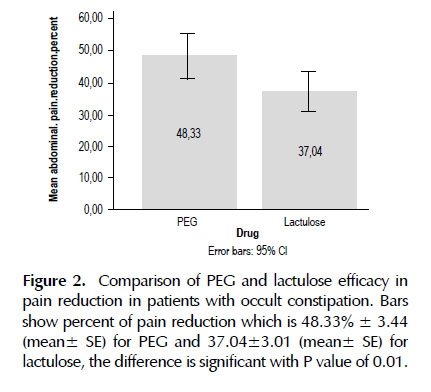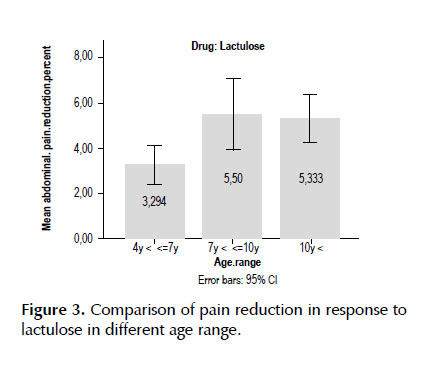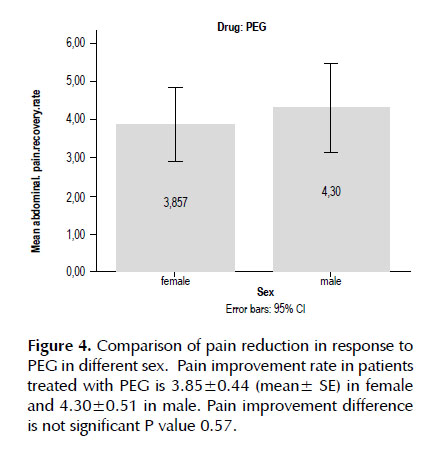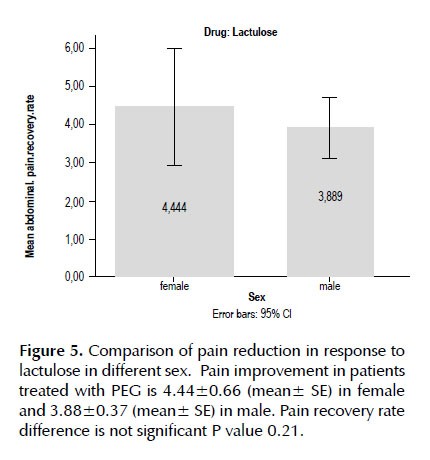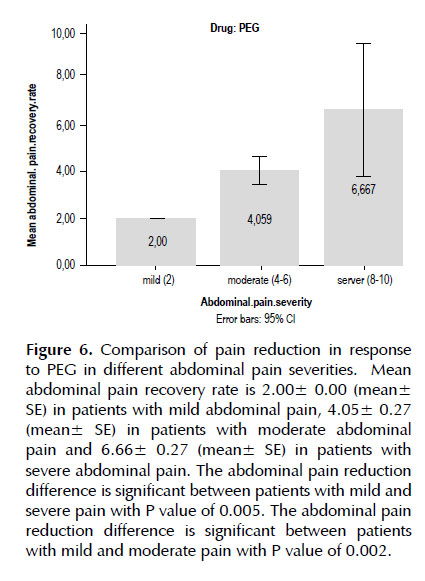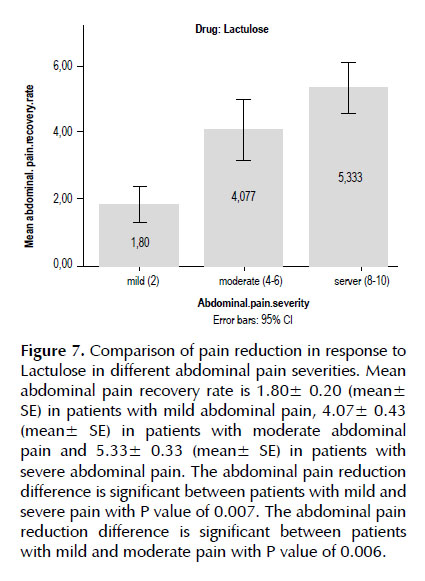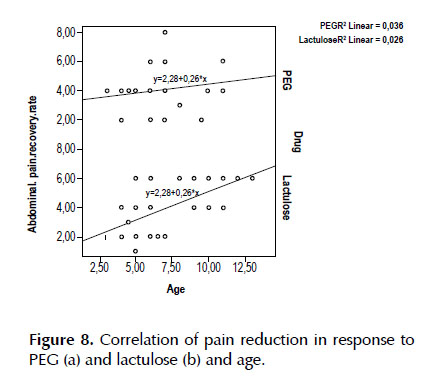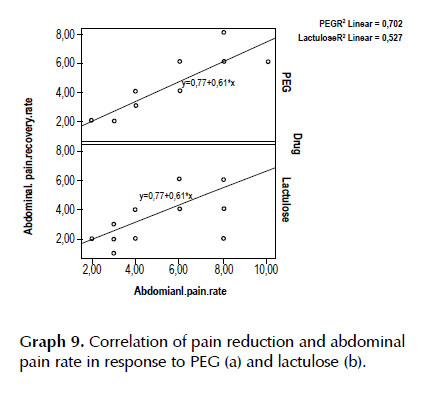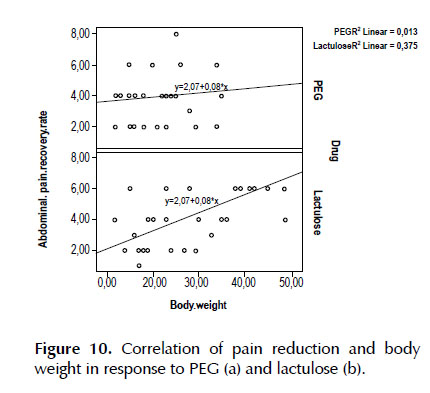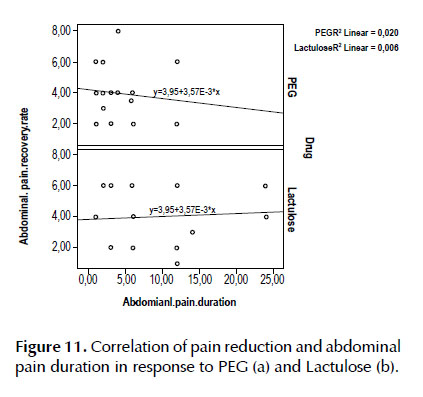Servicios Personalizados
Revista
Articulo
Indicadores
-
 Citado por SciELO
Citado por SciELO
Links relacionados
-
 Similares en
SciELO
Similares en
SciELO
Compartir
Revista de Gastroenterología del Perú
versión impresa ISSN 1022-5129
Rev. gastroenterol. Perú vol.39 no.4 Lima oct./dic 2019
ARTÍCULOS ORIGINALES
Effect of polyethylene glycol versus lactulose on abdominal pain in children occult constipation: a randomized controlled study
Efecto del polietilenglicol versus lactulosa sobre el dolor abdominal en el estreñimiento oculto en niños: un estudio controlado aleatorio
Mehran Hakimzadeh1 , Sayeh Mottaghi1, Mitra Ahmadi1, Hazhir Javaherizadeh1,2
1. Dept. of Pediatric Gastroenterology, Abuzar Children’s Hospital, Ahvaz Jundishapur University of Medical Sciences. Ahvaz, Iran.
2. Alimentary Tract Research Center, Ahvaz Jundishapur University of Medical Sciences. Ahvaz, Iran.
ABSTRACT
Introduction and aim: Functional abdominal pain (FAP) is one of the major gastrointestinal complaints in childhood. Studies have reported occult constipation (OC) as one of the leading causes of abdominal pain. Recent researches have proposed laxatives as potent therapeutic targets for abdominal pain in patients with OC. However, no study has compared effect of poly ethylene glycol (PEG) and lactulose on occult constipation. Materials and methods: 51 patients aged 4 to 18 years with abdominal pain who had OC (defined as fecal impaction in abdominal X ray) were studied. Demographic and clinical data including age, sex, body weight, height, abdominal pain duration, abdominal pain rate and fecal odor were registered. They were randomly assigned to receive PEG (1gr/kg) or Lactulose (1cc/kg) for at least two weeks. All patients were reevaluated by pain measurement scale after at least two weeks of treatment. Results: It is indicated that the efficacy of PEG for reducing abdominal pain in OC was 48% while it was 37% for Lactulose. This study indicated that this efficacy is not affected significantly by sex and fecal odor, however this efficacy is influenced by age, body weight, abdominal pain duration and abdominal pain rate for both PEG and Lactulose. Conclusion: It could be concluded that PEG is a more efficient drug for treating abdominal pain in occult constipation than Lactulose and its optimum effect can be achieved in elder patients with more severe abdominal pain.
Keywords: Abdominal pain; Constipation; Polyethylene glycol; Lactulose (source: MeSH NLM).
RESUMEN
Introducción y objetivo: El dolor abdominal funcional (FAP) es una de las principales molestias gastrointestinales en la infancia. Los estudios han informado que el estreñimiento oculto (OC) es una de las principales causas de dolor abdominal. Investigaciones recientes han propuesto laxantes como objetivos terapéuticos potentes para el dolor abdominal en pacientes con OC. Sin embargo, ningún estudio ha comparado el efecto del polietilenglicol (PEG) y la lactulosa sobre el estreñimiento oculto. Materiales y métodos: Se estudiaron 51 pacientes de 4 a 18 años con dolor abdominal que tenían OC (definida como impactación fecal en rayos X abdominales). Se registraron datos demográficos y clínicos que incluyen edad, sexo, peso corporal, altura, duración del dolor abdominal, tasa de dolor abdominal y olor fecal. Fueron asignados aleatoriamente para recibir PEG (1 gr/kg) o lactulosa (1 cc/kg) durante al menos dos semanas. Todos los pacientes fueron reevaluados por la escala de medición del dolor después de al menos dos semanas de tratamiento. Resultados: Se indica que la eficacia de PEG para reducir el dolor abdominal en OC fue del 48% mientras que fue del 37% para la lactulosa. Este estudio indicó que esta eficacia no se ve afectada significativamente por el sexo y el olor fecal, sin embargo, esta eficacia está influenciada por la edad, el peso corporal, la duración del dolor abdominal y la tasa de dolor abdominal tanto para PEG como para lactulosa. Conclusión: Se podría concluir que el PEG es un fármaco más eficaz para tratar el dolor abdominal en el estreñimiento oculto que la lactulosa y que su efecto óptimo se puede lograr en pacientes mayores con dolor abdominal más severo.Palabras clave: dolor abdominal, estreñimiento oculto, polietilenglicol, lactulosa.
Palabras clave: Dolor Abdominal; Estreñimiento; Polietilenglicol; Lactulosa (fuente: DeCS BIREME).
INTRODUCTION
Occult constipation (OC) is a clinical condition in which patient have no obvious complaint of constipation or no symptom in relation to constipation, expect for having hard consistency of stool in rectal exam or having fecal impaction in abdominal X ray. In the study by Edlitz-Marcus et al. occult constipation was defined as the absence of complaints of constipation on initial medical history or of symptoms to indicate the presence of constipation. Rectal examination and/or plain abdominal X-ray was for diagnosis (1). Fecal retention was proposed as a cause of recurrent abdominal pain in children (1). The association between functional abdominal pain (FAP) and occult constipation is reported in various studies (1-3).
A recent study performed on 2017, reported that approximately 52.4% of patients with FAP and Leech score more than eight are presumed to have occult constipation (4). Therefore, suggestion of the most potent therapeutic drug for abdominal pain in OC is of great importance. Few numbers of studies have investigated effect of Laxatives on abdominal pain in OC, although the efficacy of PEG and Lactulose on abdominal pain reduction in OC remains unknown still.
In this study we were to assess PEG and lactulose efficacy in reducing abdominal pain in children with occult constipation.
MATERIALS AND METHODS
In this study 58 patients aged 4 to 18 years with at least two weeks of abdominal pain who had fecal impaction in abdominal X-ray while did not meet ROME III criteria for constipation were enrolled. These children had not other criteria of ROME III for constipation. Fecal impaction was diagnosed using plain radiography by an expert pediatric gastroenterologist. Plain radiography is a cost effective and non-invasive method for assessment of fecal impaction (5,6).
Patients was visited according to abdominal pain without alarm sign. Then 7 patients with past medical history of surgery, recent drug history of antibiotics or Laxatives and history of hematochezia were excluded. Fifty-one patients were studied their demographic and clinical information including age, sex, body weight, height, fecal odor, abdominal pain duration, address and abdominal pain rate were registered. They were randomly divided into two groups for receiving PEG (1gr/ kg/day) or Lactulose (1cc/kg/day) for at least two weeks.
For a better evaluation of drug efficacy in different abdominal pain severities patients were stratified into three subgroups of mild, moderate and severe abdominal pain based on abdominal pain measurement scale. Figure 1.
Patients were reevaluated for abdominal pain rate and their score was measured based on abdominal pain measurement scale from 0 to 10. Statistical analysis was performed using SPSS23 software. A x2 test was performed for group comparisons. Linear Logistic regression analysis was performed to assess the correlation between efficacy variable of PEG and Lactulose with abdominal pain rate, age, abdominal pain duration, body weight. A P value less than 0.05 was considered statistically significant. This study was approved by ethics committee of Ahvaz Jundishapur University of Medical Sciences ) IR.AJUMS. REC.1396.901) and informed consent was obtained from patients or their caregivers at enrollment. This clinical trial was registered at Iranian Registry of Clinical Trial with number IRCT20181214041966N1.
RESULTS
In this study 45.1% (23) of the studied population were female and 54.9% (28) were male. In this study 47.1 % (24) of patients were treated with PEG and 52.9% (27) of them were treated with Lactulose. Percentage of pain reduction in PEG and Lactulose group was 48.33±3.44 and 37.04±3.01 respectively(p=0.01). The result showed that PEG was more effective than Lactulose on pain reduction (Figure 2).
For a more comprehensive evaluation of age influence on drug efficacy on abdominal pain in OC, patients were stratified into three subgroups 64.7% (33) were 4 to 7 y/, 19.6% (10) were 7 to 10 years, and 15.7% (8) were older than 10 y/o. This work indicated that there is a significant difference between age range and abdominal pain reduction in response to Lactulose and patents at the age of 7 to 10 y/o had the best results. (P value 0.006) (Figure 3) that’s while it was indicated that there is no significant difference between different age range and abdominal pain reduction in response to PEG. (P value 0.49).
Bars show mean abdominal pain improvement in different age range in patients treated with Lactulose which is 3.29± 0.39 (mean± SE) in 4 to 7 years patient, 5.50± 0.50 (mean± SE) in patients 7 to 10 years and 5.33± 0.42 (mean± SE) in patients elder than 10 years. Pain improvement rate difference is significant in 4 to 7 years and 7 to 10 years with P value of 0.01, Pain improvement rate difference is significant in 4 to 7 years and elder than 10 years with P value of 0.009.
This study demonstrated that there is no significant difference between different sex abdominal pain reduction in response to lactulose (P value 0.46) (Figure 4) and is not significant difference between different sex abdominal pain reduction in response to PEG (P value 0.85) (Figure 5).
In this study 17.6% (n=9) of the participants had mild abdominal pain, 58.8% (n=30) had moderate abdominal pain and 23.5% (n=12) had severe abdominal pain. This study demonstrated that there is a significant difference between abdominal pain reductions in response to PEG in different abdominal pain severities, the highest efficacy was achieved in severe abdominal pain (P value 0.001) (Figure 6). It was also demonstrated that there is a significant difference between abdominal pain reductions in response to PEG in different abdominal pain in reductions response to
Lactulose in different abdominal pain severities, the best result was achieved in patients with severe abdominal pain (P value 0.012) (Figure 7).
To better evaluate effect of abdominal pain duration on drug efficacy patients were divided into three subgroups; patients with abdominal pain for less than 3 months, abdominal pain for 3 to 6 months and abdominal pain more than 6 months. In this study 23.5% (n=12) of patients had less that 3m pain, 31.4% (n=16) had 3 to 6m pain and 45.1% (n=23) had more than 6m pain. This research shows no significant difference in pain reduction in response to Lactulose between subgroups of abdominal pain duration (P value 0.4(. There was also no significant difference in pain reduction in response to PEG between subgroups of abdominal pain duration (P value 0.09).
This work indicated that there is significant positive correlation between age and pain reduction in response to PEG (P value 0.006) (Figure 8a). It was also indicated that there is a significant positive correlation between age and pain reduction in response to lactulose (P=0.012) (Figure 8b).
This study demonstrated that there is a significant positive correlation between abdominal pain rate and its reduction in response to PEG (P value 0.006) (Figure 9a ]. It was also demonstrated that there is a significant positive correlation between abdominal pain rate and its reduction in response to lactulose (P value 0.012) (Figure 9b).
This study reports that there is significant correlation between body weight and abdominal pain reduction in response to PEG (P value 0.006) (Figure 10a). It was also found that there is significant correlation between body weight and abdominal pain reduction in response to lactulose (P value 0.012) (Figure 10b).
There is a significant negative correlation between abdominal pain duration and its reduction in response to PEG (P value 0.006) (Figure 11a). It was also demonstrated that there is a significant positive correlation between abdominal pain duration and its reduction in response to PEG (P value 0.012) (Figure 11b).
DISCUSSION
Occult constipation; is a clinical condition with the characteristic feature of fecal impaction in abdominal X ray, is found to be one of cause of abdominal pain (1). The association between FAP and occult constipation has been reported in several studies (2,3). In a study performed on 2017, approximately 52.4% of patients with FAP were indicated to have OC (4). Few studies have reported efficacy of Laxatives in treating FAP, which effect is reported to be especially significant in those affected by occult constipation. Another study performed by Gijsbers CF et al. on 2014, have proposed occult constipation as a common cause of abdominal pain in children and it was concluded that laxatives play a pivotal role in the recovery of patient with FAP (2). This study is in consistence with the present study that both PEG and Lactulose could significantly reduce abdominal pain in patients with OC.
In the current study we showed that PEG was significantly more effective than Lactulose in pain reduction in children with occult constipation. In the study by Jarzebicka et la., abdominal pain was more frequent in children who treated by lactulose than children who treated by PEG3350 (7).
There are a few studies in the subject of occult constipation. But in the constipation children, some studies showed that PEG was more effective than Lactulose (7-9). In another systematic review by Gordon et al., PEG may be superior to placebo or Lactulose for the treatment of childhood constipation (10).
In conclusion, this study highlights the potential of Laxatives use for treating abdominal pain in OC and shows the need for more investigation to find out the most effective laxative in treating abdominal pain in OC. In conclusion we found out that both PEG and Lactulose are effective in treating abdominal pain in OC, however the efficacy of PEG is significantly more than Lactulose. The tolerability and efficacy of PEG in treating abdominal pain in OC may suggest it as drug of choice in treating abdominal pain in OC. More over the optimum effect of PEG could be achieved in elder children with more severe abdominal pain for a less duration of abdominal pain.
Study limitation: Single center study and duration of follow up were the most important limitation. Also, this study was done in tertiary hospital, so our result may be not applicable to general population. We could not use placebo in the treatment children with abdominal pain due to ethical issue.
Acknowledgment: This study was approved by research affair of Ahvaz Jundishapur University of Medical Sciences. The source of this thesis was from residency thesis of pediatric residency thesis of Dr. Sayeh Mottaghi.
Conflict of interest: None.
Citar como: Hakimzadeh M, Mottaghi S, Ahmadi M, Javaherizadeh H. Effect of polyethylene glycol versus lactulose on abdominal pain in children occult constipation: a randomized controlled study. Rev Gastroenterol Peru. 2019;39(4):323-8
REFERENCES
1. Eidlitz-Markus T, Mimouni M, Zeharia A, Nussinovitch M, Amir J. Occult constipation: a common cause of recurrent abdominal pain in childhood. IMAJ. 2004;6:677-80. [ Links ]
2. Gijsbers CF, Kneepkens CM, Vergouwe Y, Buller HA. Occult constipation: faecal retention as a cause of recurrent abdominal pain in children. Eur J Pediatr. 2014;173(6):781-5. [ Links ]
3. Gijsbers CF, Kneepkens CM, Schweizer JJ, Benninga MA, Buller HA. Recurrent abdominal pain in 200 children: somatic causes and diagnostic criteria. Acta Paediatr. 2011;100(11):e208-14. [ Links ]
4. Ha EK, Jang H, Jeong SJ. Therapeutic response for functional abdominal pain in children with occult constipation: laxatives versus prokinetic drugs. J Korean Med Sci. 2017;32(1):102-7. [ Links ]
5. Leech SC, McHugh K, Sullivan PB. Evaluation of a method of assessing faecal loading on plain abdominal radiographs in children. Pediatr Radiol. 1999;29(4):255-8. [ Links ]
6. Rezazadeh A, Javaherizadeh H, Chahardahcherik F, Yavarahmadi MH, Sadjadei N, Tahmasebi M. Reliability of Barr, Leech, and Blethyn score in using of plain radiography in determining fecal impaction in children with and without constipation. Arq Gastroenterol. 2016;53(3):141-5. [ Links ]
7. Jarzebicka D, Sieczkowska-Golub J, Kierkus J, Czubkowski P, Kowalczuk-Kryston M, Pelc M, et al. PEG 3350 Versus lactulose for treatment of functional constipation in children: randomized study. J Pediatr Gastroenterol Nutr. 2019;68(3):318-24. [ Links ]
8. Treepongkaruna S, Simakachorn N, Pienvichit P, Varavithya W, Tongpenyai Y, Garnier P, et al. A randomised, double- blind study of polyethylene glycol 4000 and lactulose in the treatment of constipation in children. BMC Pediatr. 2014;14:153. [ Links ]
9. Dupont C, Leluyer B, Maamri N, Morali A, Joye JP, Fiorini JM, et al. Double-blind randomized evaluation of clinical and biological tolerance of polyethylene glycol 4000 versus lactulose in constipated children. J Pediatr Gastroenter Nutr. 2005;41(5):625-33. [ Links ]
10. Gordon M, MacDonald JK, Parker CE, Akobeng AK, Thomas AG. Osmotic and stimulant laxatives for the management of childhood constipation. Cochrane Database Syst Rev. 2016;(8):CD009118. doi: 10.1002/14651858.CD009118.pub3. [ Links ]
Correspondence:
Hazhir Javaherizadeh
Associate Professor of Pediatric Gastroenterology, Alimentary Tract Research Center, Ahvaz Jundishapur University of Medical Sciences, Ahvaz, Iran














